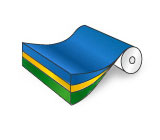
HERMA rPE PCR white (856)/72F/P23
HERMA rPE PCR white (856)
Recycling Polyethylen film white, with corona pretreatment
Adhesive 72F
Permanent, acrylic based adhesive
HERMA PH (501)
Natural-coloured, supercalendered glassine
Service Information
| Useable width | Largeurs de filet disponibles | Minimum quantity in m2 | Stock goods | Provisioning Time |
|---|---|---|---|---|
| 1.003 mm |
|
3.000 m² |
|
Environ 2 semaines |
Matériau autoadhésif
HERMA rPE PCR white (856)/72F/P23
| Grammage | approx. 138 g/m² | ISO 536 |
| Total caliper | approx. 130 µm | ISO 534 |
| Service temperature | -30 to 100 °C |
The corona pretreated surface of HERMA rPE PCR white (856) offers a good print quality in conventional printing techniques. Before printing we recommend to refresh the corona pretreatment. This recycled film contains gel particles. The number and size depends on the quality of the post consumer recyclate (PCR) and can therefore vary. Depending on the size and shape of the gel particles, there may be variations in ink acceptance. It may therefore be necessary to adjust the printing and die-cutting process. Due to the production from post consumer recyclate, variations in ink adhesion are also possible. In this case, we recommend using a primer. This recycled film is also suitable for thermal transfer printing. Pre-testing is recommended. HERMA rPE PCR white (856) is perfect for the production of visually de manding labels that underline the recycling design and are preferably used on PE surfaces.
Composition of HERMA rPE PCR white (856)
The content of plastic recyclate from post-consumer recyclate (PCR) is ≥ 94%. The masterbatches and additives added during film production, such as white pigments, anti-blocking agents or processing aids, are not counted as recyclates. Therefore, the total recyclate content is always < 100%.
PCR materials may have a stronger inherent odour than virgin PE materials.
RecyClass Certification: HERMA rPE PCR weiß (856) complies with the requirements set out in EN 15343:2007.
Our contribution to sustainability: Only PCR plastics are used in the production of this film. Recycled plastics help us to reduce greenhouse gas emissions and thus effectively combat climate change. At the same time, we can contribute to reducing plastic waste and promote the collection, sorting and recycling of plastic waste to create a circular economy.
Adhesive 72F was developed specifically for use in a sustainable labelstock. The raw materials required for its production are based on the so-called biomass balance approach, in which biomass from organic waste is used instead of fossil raw materials. The 72F adhesive is characterized by a high tack with very high cohesion and very good final adhesion. Due to this high cohesion, Adhesive 72F shows a low tendency to creep, so that adhesive bleed is largely avoided. Furthermore, the UV stability of 72F is extremely high and the wetting of polar substrates such as glass and steel is very good. 72F has particularly good resistance to light, heat, water and aging.
The supercalendered glassine with unbleached fibres is perfectly suited for assignment in labelling machines equipped with optical or mechanical scanners.
Paper fibre contents:- unbleached virgin fibres: ca. 50 %- bleached virgin fibres: ca. 35 %- bleached recycling fibres: ca. 15 %
The glassine paper shows a reduced PCF in comparison to an equivalent paper without unbleached fibres.
Excellent die-cutting characteristics on all customary machines.
As part of a self-adhesive compound HERMA PN (501) offers excellent die-cutting characteristics with all customary flatbed and rotary die-cutting tools.
Storing at a temperature of 20 ± 5 °C, a relative humidity of 45 ± 5 % and a dark storage is recommended. Moisture, heat and direct sunlight have to be avoided.
The shelf life is from date of production.
All ingredients of adhesive 72F comply with recommendation FDA 21 CFR 175.105 (Adhesives).
The pressure-sensitive adhesive 72F can be safely used for the back coating of labels for the labelling of foodstuffs for storage at room temperature and below. It may be used in direct contact with dry, moist and fatty foodstuffs. Furthermore, the adhesive may be used for laminating various materials. In this case, cut edge contact with food is harmless as far as the above mentioned adhesive is concerned. It must be ensured that the relevant migration limits are complied with by the laminated packaging. Moreover, the adhesive may be used for the labelling of blood bags (Declaration of no objection valid until 06.04.2025).
The paper complies with recommendation BfR XXXVI.frontal
HERMA rPE PCR white (856)
Recycling Polyethylen film white, with corona pretreatment
| Grammage | approx. 63 g/m² | ISO 536 |
| Caliper | approx. 65 µm | ISO 534 |
| Tensile stress (MD) | approx. 22 N/mm² | ISO 527 |
| Tensile stress (CD) | approx. 21 N/mm² | ISO 527 |
| Opacity | approx. 70 % | ISO 2471 |
autoadhésif
Adhesive 72F
Permanent, acrylic based adhesive
| Tack | high | |
| Peel adhesion | very high | |
| Shear | very high |
Backing/liner
HERMA PH (501)
Natural-coloured, supercalendered glassine
| Grammage | approx. 54 g/m² | ISO 536 |
| Caliper | approx. 47 µm | ISO 534 |
| Tensile strength (MD) | approx. 74 N/15 mm | DIN 53112 |
| Tensile strength (CD) | approx. 32 N/15 mm | DIN 53112 |
| Transparency | approx. 42 % | DIN 53147 |
All statements, technical information and recommendations regarding HERMA products are given in good faith and are based on tests that we believe to be reliable, but do not constitute a guarantee or warranty. We give no guarantee as to the suitability of the product for a specific application, this should be tested by the user. Unless otherwise agreed in writing, we only accept liability within the scope of our General Terms and Conditions of Delivery and Payment.
HERMA GmbH, Adhesive Material Division, 70791 Filderstadt, Phone +49 (0) 711 7702-0